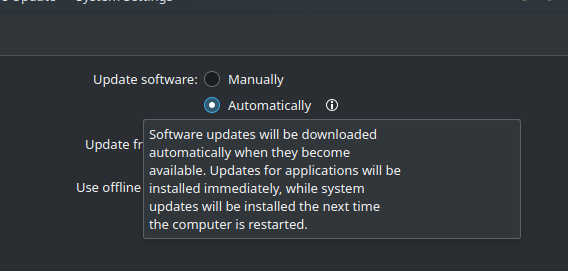#1 is just not being the default for 99% of devices. If someone gets a new computer, why would they go through the effort of installing a new os when the one it comes with works fine? Hell, I bet at least 50% of people in the market for a pc don’t even know what an OS is.
I bet at least 50% of people in the market for a pc don’t even know what an OS is.
70%*
New user: I have a problem 😊
Everyone:👍
- are you on xorg or wayland?
- pulseaudio or pipewire?
- what WM/DE are you using?
- amd or nvidia?
- what distro?
- systemd?
New user: Nevermind 😮💨
if a new user is using a distro that doesn’t use systemd they fell for a meme
if a new user is using a distro that doesn’t use systemd they fell for a meme
Or they hate fridge art like systemd and are on something like PCLinuxOS or Alpine.
That’s what I mean though, why would a new user be running alpine as a desktop os?
At this point, my biggest dream is that these ‘new user’ distros used only Wayland, Pipewire, Systemd and Flatpaks simply to simplify things. Hopefully we’re less than 2024 away from NoVideo Wayland support.
Also as soon as XFCE releases their Wayland support, that soon it’ll become the most famous DE choice of Mint.
What I am really happy is to see how well supported Pipewire already is. Pipewire has never showed any problem in the new installs for me.
The problem with that is most major distros market themselves as “new user” distros to some extent though. Noob-friendly, out-of-the-box, easy, etc are all distro-marketing buzz-words that mean nothing.
You can’t expect them to only use Wayland, Pipewire, Systemd, and Flatpaks because that dream requires every distro to use Wayland, Pipewire, Systemd, and Flatpaks, which will never be reality.
Most distros will probably eventually adopt these tools, but there won’t be a sudden shift. It will be gradual.
Well, for Pipewire it’s the apps which needs to adjust at this point. Only thing missing currently is the Wayland but it’s coming. Making Linux less fragmented (read: confusing), the more new users will give a try.
Systemd
Fridge art. Fuck, they MAYBE have nfsroot working. MAYBE. After a decade of fucking around, when it was available for ages. The number of bags on the side of lennart’s piece of crap, just to reinvent the wheels we had before, is absolutely ridiculous.
and Flatpaks
… break single source of truth for as-built information and current software manifest. This kills validation, which dissolves certainty on consistency, then repeatability. And given the state of the software load exported to management tools is NOT the flatpak source of truth, you now have a false negative on the ‘installation’ of a flatpak resource when checking it via management.
Oh. That needs to be on the interview questions.
pipewire seems ready for primetime but I’m more dubious about Wayland. For instance KDE appears to still be a bit flaky and sway still works poorly under Nvidia and will never have proper mixed DPI for xwayland apps. Still seems like a tradeoff vs X which doesn’t require a compromise. XFCE is roughly 10% of Mint users. Mint users are unlikely to switch because of wayland support
Doing tech support, I encountered this attitude. People like that are nearly impossible to help. “Why can’t you just fix it!” The true answer never given is that your problem is probably something stupid you are doing, like trying to make a phone call by physically shoving the phone entirely up your asshole, and until I run through some common problems and ask some questions, I won’t be able to tell you to have your significant other get the salad tongs and pull it out of your rear and then go over “dialing.”
People mostly need to be willing to gather detailed system info with Inxi and share it.
I’ll have you know I get better reception when it’s up my ass!
So you want them to provide answers by using magic? If you seek support for any software, open source or otherwise, you’ll need to tell them version, build number etc. Why do you think Linux will be any different?
Because people can already barely provide this level of information for a Windows device. Most of these words look like technobabble to non-tech-enthusiasts
Of course the words will be different. They aren’t hard words. And they can be answered very easily. In fact, most forums ask to include an output of something like
inxi -Fazywith every question, thus eliminating the need for all of these things.For more niche problems, people might ask for more specific information. But most of the time, they’ll tell you exactly what to run to get that information.
You know what’s the Windows alternative for this? Most of the time, nothing. You need to reinstall Windows. Mac is similar, except you need to have it replaced. You actually CAN repair Linux. That’s the difference.
Why don’t you magically have a magic button that magically fixes everything with no effort of my own? That’s stupid, I think I will go on social media and repeatedly tell everyone that Linux is bad actually
- Self updating without user interaction per default.
- Better support of codecs and drivers.
Linux does have better codecs and drivers than Windows for some stuff (Bluetooth for example), but it has worse codecs and drivers for some important proprietary hardware stuff (Nvidia for example)
deleted by creator
See, that paragraph alone is too much for the majority of non-Linux users.
i believe fedora has this by default

Self updating without user interaction per default.
I think that this is a terrible idea, until a clear boundary is set between applications that can or cannot break the system. Updating flatpaks automatically might be fine, but updating everything is simply a recipe for disaster.
Based on my tests on my family and friends, the main problem is tech support. Most geeks seem to assume other people want the same things than themselves (privacy, freedom, etc). Well, they don’t. They want a computer that just works.
Overall when using Linux, people actually don’t need much tech support, but they need it. My father put it really well by saying: “the best OS is the one of your neighbor.”
I apply few rules:
-
The deal with my family and friends is simple: you want tech support from me ? ok, then I’m going to pick your computer (usually old Lenovo Thinkpads bought on Ebay at ~300€) and I’m going to install Linux on it.
-
I’m not shy. I ask them if they want me to have remote access to their computer. If they accept, I install a Meshcentral agent. Thing is, on other OS, they are already spied on by Google, Microsoft, Apple, etc. And most people think “they have nothing to hide”. Therefore why should they worry more about a family member or a friend than some unknown big company ? Fun fact, I’ve been really surprised by how easily people do accept that I keep a remote access on their computer: even people that are not family ! Pretty much everybody has gladly agreed up to now. (and God knows I’ve been really clear that I can access their computer whenever I want).
-
I install the system for them and I make the major updates for them. Therefore, if I have remote access to the system, I pick the distribution I’m the most at ease with (Debian). They just don’t care what actually runs on their computers.
-
When they have a problem, they call me after 8pm. With remote access, most problems are solved in a matter of minutes. Usually, they call me a few times the first days, and then I never hear from them anymore until the next major update.
So far, everybody seems really happy with this deal. And for those wondering, I can see in Meshcentral they really do use those computers :-P
When i told my dad i can install Rustdesk on his computer to do remote support (moved out), he asked me “does that mean you can look at my computer whenever you want?”. I’m really proud of him, he actually listened.
I think people sell themselves short with regards to having undue access to family members’ computers. If they’re willing to give it then you’ve clearly demonstrated that you’re trustworthy and haven’t given them reason to assume you’ll snoop or worse steal from them.
Are there any limitations to Meshcentral? I tried using Team Viewer and a few others when I was supporting family on Windows, and they all wanted to charge me after a while.
-
Linux really isn’t ideal for anyone who isn’t already a tech enthusiast on some level. I recently did a fresh install of Kubuntu and after about a week, it prompted me that there were updates, so I clicked the notification and ran the updates, after which my BIOS could no longer detect the UEFI partition. I had to use a live usb to chroot into the system and repair it, as well as update grub, in order to fix it.
It’s fixable, but this is not something anyone who doesn’t already know what they’re doing can fix. I’ve had auto updates in the past put me on boot-loops thanks to nvidia drivers, etc.
This kind of thing needs to almost never happen for linux to be friendly for those who just want their computer to work without any technical understanding. This, honestly though, can’t happen because of the nature of distros, you can’t ever make guarantees that everything will work because every distro has slightly different packages.
Wine is getting better, but compatibility is still an issue, especially for people who rely really heavily on microsoft office or adobe products.- Installation process of Linux is complicated to an average Joe (Bootable USB/ISO file/Boot priority/format <- what are these scary terms?)
- Lack of availability of pre-installed Linux PCs at physical shops
- Lack of availability of industry-standard software
- Confusion for an average Joe due to excess choice of distros/application packaging format. Average people don’t want choices, they want to be guided.
- (Minor point) Most available guides for doing something heavily requires terminal usage which can be daunting to new users
deleted by creator
Yeah honestly same, I hate having to sudo into random system files to change something basic or having to open a terminal and remember the specific magic words to do what I need
so whenever I have the option I use GUI over CLI every time
This is heavily influenced by choice of DE. Some of them really do have all their options well laid out in the system settings, but others rely entirely on config files. I have little experience with GNOME, but with KDE I was able to customize my experience very heavily using only the system settings by just playing around in the GUI. Meanwhile, on another machine running Hyprland, I have had to read a lot of documentation in order to customize it, but the available options are relatively more powerful than the KDE setup.
Neither of these methods are more right than the other, but one is absolutely more new-user friendly, assuming they do not want to simply accept the defaults.
When’s the last time the average user has had to install an operating system?
That’s the biggest obstacle right there. I think plenty of non-techy people would use linux if it came preinstalled.
Also, if it came pre-installed, one would assume all the hardware was properly supported. A big pain point with Linux is that sometimes things just don’t work right, and there’s nobody to turn to for help except Google. It’s been a while since I attempted to run Linux on a laptop, but when I did I struggled a lot getting good battery life, good trackpad support, and a sleep mode that worked correctly.
Reputations live on for decades after they are earned. Perhaps all of my laptop problems are ancient history, but I have no way to know without trying, and it’s too much effort.
I have an example: a little whole ago I put Arch on my 2-in-1 laptop just because I prefer open-source philosophy, and although a lot of things worked out-of-the-box, my biggest problem was the actual 2-in-1 function. I know that, like Windows, I’d have to do a little digging to get it working (except Windows would involve drivers, Linux required settings) and I got a makeshift solution working: KDE has its own screen-rotating feature, and I made 2 shell commands on the desktop that, when pressed, disable/enable the keyboard/trackpad. Turns out it only works on Xorg, and Wayland requires a way more complicated setup to work, so I just gave up using Wayland on it. Something to do with udev rules or something
It needs to “just work”. It’s not more complicated than that.
- All of the basics should just work well out of the box with minimal tweaking. Yes even NVIDIA stuff.
- The software center needs a massive overhaul. It feels like an afterthought by people who would rather use a command line.
Yeah, the descriptions and lack of curation is really weird … browse games and oh look here’s 27 varieties of reversi and a driving game that crashes on launch.
If it were a curated list with enthusiastic and helpful descriptions it would make it more accessible to use. Get the mature and professional looking programs front and center.
Much as I hate to say it, it could do with a makeover from someone with a sense of marketing. (Excuse me for a second, I felt a little nauseous saying that).
Speaking from experience, from a long time ago, and from the people/family I’ve installed it for on older machines: It’s different. That’s 90% of it.
The people that had little to no windows/PC experience actually took to Linux a lot easier not having to relearn/change habits from windows.
Correct. It’s lack of familiarity. Once Linux gets around 10-15% market share, enough people who know the quirks of Linux to help new people who then Linux will be big.
Yes, I had my mom start with Linux and she’s confused when she has to use Windows.
To be honest, one part is what everyone mentioned here. Not being preinstalled and all that.
The other part is that unfortunately at least according to my own expirence as a Linux noob a few years ago some Linux communities can be very toxic. If you’re asking questions of how to do X and someone comes along and is all “why do you even want to do X if you could also do Y? Which is something entirely different but also does something vaguely similar”
That’s one if the things.
And then other curiosities. I cannot for example for the life of me get my main monitor to work under Linux with any new Kernel version. My Laptop just refuses to output to it or the second monitor attached via Display port daisychaining. On the older version it works, on the newer it’s broken. I have tried troubleshooting this problem for over half a year and it’s still broken. And that’s out of the Box on Ubuntu LTS…
So i don’t really understand this question. There are major roadblocks. With Wayland which is default for Ubuntu now those roadblock jist became bigger. Screensharing in multiple Apps including slack is outright broken unless you use the shitty webapp. The main player Office 365 largely doesn’t work at all on Linux. All these things that should work for a Desktop operating System don’t work out of the Box as they should.
That’s why people aren’t using it and companies aren’t preinstalling it.
You have to use the terminal
Anything using the terminal… I once tried to do something on Linux because a friend told me it was great. I gave it another go when it came up on my Chromebook and tried to teach myself. I just don’t get it.
I’m not a programmer at all, so anything that involves typing commands is going to baffle me!
One thing i had to learn when i started to understand how big techs really work, of what that would imply (see chat control) and get passionate about free software, free operative systems and freedom of customization is that freedom itself almost always requires work, the question is: is that a work you’re willing to do? for me the answer is a strong YES.
For the average user all that extra works gives them very little return.
Most people don’t want everyday computer use to be work.
Fair.
But I was just giving my perspective as an outsider who stumbled across this post because messing about with the terminal had the opposite affect on me as someone who appreciates the concept of Linux but doesn’t really have the level of passion to learn programming for it.
YES! I fucking hate it. I shouldn’t have to enter code in order to install a program. I want to go to a website and download the software, click install, and have it actually just work.
I’ve used mint for several years now but it will never be a primary OS die my household because it’s such a hassle to work with.
On many popular distros there are graphical apps preinstalled for that. The distribution maintainers have repositories with common packages to make it so that you can open an app store and install programs from one place rather than going to different websites and downloading installers.
To me, the big problem is still updates breaking things.
Everybody needs to update their system from time to time, but if doing so leaves your system in an unusable (for the average person, not a linux terminal guru) state, users aren’t going to stay.
I think immutable/atomic OSes like Silverblue, VanillaOS and SteamOS are heading in the right direction to solve this issue. Particularly if they allow users to easily rollback a bad update. Otherwise maybe there is some way to detect and warn about potential compatibility issues before people update.
Linux should be teach at school instead of windows. Most people assume Linux is harder only because they are not used to it. Once you get accustomed you realize that it’s even easier, for example in popular distros with package manager opening a terminal and write a 3 words command followed by the name of software, as hard as it may sound, it’s much easier and fast than using google to download shady .exe files that needs to be installed manually.
Also people really needs to stop being lazy. You don’t jump into a car and drive it if you don’t know how to do it. If you are not down to spend 2 hours of your life learning how to use a machine you use daily you really should change mindset.





















